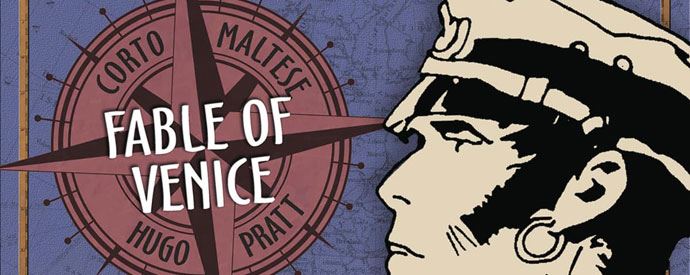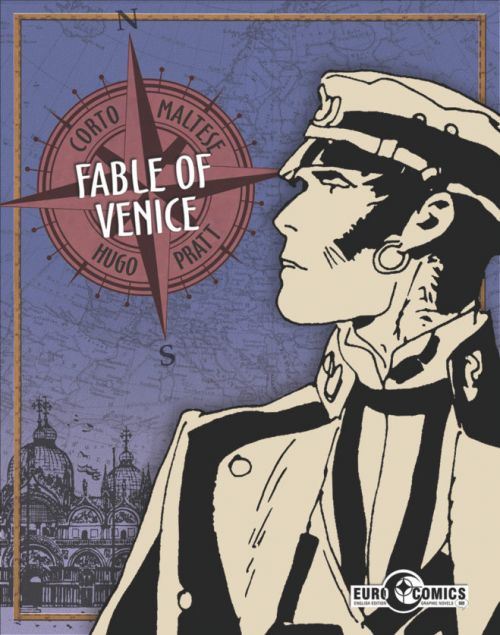Comics /
European Comics
Corto Maltese: Fable of Venice comics review

By Leroy Douresseaux
January 24, 2018 - 00:33
 |
| Corto Maltese: Fable of Venice cover image |
Hugo Pratt (1927 to 1995) was an Italian comic book creator and artist. Some consider him to be among the first literary and artistic comic book creators, and his best known work is his
Corto Maltese series, which he produced from 1967 to 1988. Beginning with
Ballad of the Salt Sea in 1976, the series was collected in 12 books (or graphic novels).
Back in July 2014, IDW Publishing announced that it was going to publish the complete Corto Maltese in a series of twelve trade paperbacks, using Hugo Pratt’s original over-sized black and white format. These trade paperbacks (which can also be called “graphic albums”) are published under IDW's “EuroComics” imprint. They feature new translations into English from Hugo Pratt’s original Italian scripts by
Simone Castaldi, Associate Professor of Romance Languages and Literatures at Hofstra, and
Dean Mullaney, the longtime comics publisher, editor, and translator who is also the creative director of the IDW's imprints, “The Library of American Comics” and EuroComics.
In September 2017, IDW published
Corto Maltese: Fable of Venice. It was originally published in 1976 as
Favola di Venezia, the eighth book in the series. The story takes place in Venice (Pratt's hometown) in 1921 and is a mystery thriller set during the rise of Fascism in Italy.
Fable of Venice finds the enigmatic sea captain,
Corto Maltese, returning to
Venice, Italy. He has been brought to the city by the riddle of an old acquaintance,
Baron Corvo, and now, he needs to find Corvo's diary. In that diary are inscriptions related to the whereabouts of the “
Clavicle of Solomon,” a legendary emerald and magical talisman.
Corto is not the only one after this magical object that is steeped in history and mysticism. There are his friends,
Bepi Faliero and
Böeke, and the young
Blackshirts (Fascists),
Stevani and
Boselli. There is mystery woman,
Hipazia, who believes that she is the reincarnation of a prominent figure in the School of Alexandria. Corto also finds that the Freemasons and their masonic lodge,
R L Hermes, frequently pop up during his search. Freemasons, Vikings, Teutonic Knights, King Solomon, Jewish mysticism, the Queen of Sheba, Biblical figures, mysterious Arabs, and the genie of the lamp: are they all part of a quest that will unravel time and space or are they all chasing a fantasy?
THE LOWDOWN: I first heard of Hugo Pratt and Corto Maltese when Frank Miller mentioned them as influences on his work leading up to his then-new comic book,
Batman: The Dark Knight Returns. Pratt's own influences include 19th and 20th century adventure storytellers like novelist Robert Louis Stevens (
Treasure Island) and cartoonist Milton Caniff (
Terry and the Pirates).
Fable of Venice specifically is influenced by the magical realist literature of South American writers like Jose Luis Borges (whose work Pratt would have encountered during his years living and working in Argentina) and American novelist Dashiell Hammett. In fact, while reading Fable of Venice I could not stop thinking about Hammett's most famous novel,
The Maltese Falcon (1930), which was twice adapted into film, with the 1941 John Huston-Humphrey Bogart film being more famous.
So I think of Fable of Venice as a magical realist take on The Maltese Falcon set in Venice during the rise of Fascism. This is the first time that I have read a Corto Maltese graphic novel (thanks to a review copy provided to me by IDW), so I really do not know this character. What attracts me to this novel are two things.
The first thing are the characters. I cannot choose a favorite, because each one is like a delightful flavor in a wondrous hoodoo gumbo. They are simultaneously weird and recognizable and sinister and attractive. Each of these character is so eccentric and colorful that he or she makes this black and white comic seem like a spinning kaleidoscope throwing off sparklers.
The second great thing about Fable of Venice is Hugo Pratt's gorgeous black and white art and sumptuous graphical storytelling. This is simply some of the most beautiful black and white comic book art that I have ever seen. This book is like a slim, paperback version of one of editor Scott Dunbier's “Artist Editions” (also from IDW). I think that this story is so rich and complicated because Pratt maximized his over-sized pages with nine to 12 panels to page. Whereas so many American artists draw big panels and half-splash and full-splash pages, Pratt uses the 9 to 12-panel grid to delve into the details of the characters, moods, situations, and his wonderfully magical Venetian setting.
From the opening pages' Masonic gathering and Corto's arrival to the final pages' gathering of players and magical realist and surrealist ending, Pratt pushes past any imaginary boundary lines forced on the graphical and comics medium. Over 40 years after Fables of Venice was first published, Hugo Pratt's work is still ahead of most comics being published today.
I READS YOU RECOMMENDS: Those who want it good want it
Corto Maltese.
A+
10 out of 10
EuroComics.us
Rating: 10 /10
Last Updated: January 17, 2025 - 08:20

